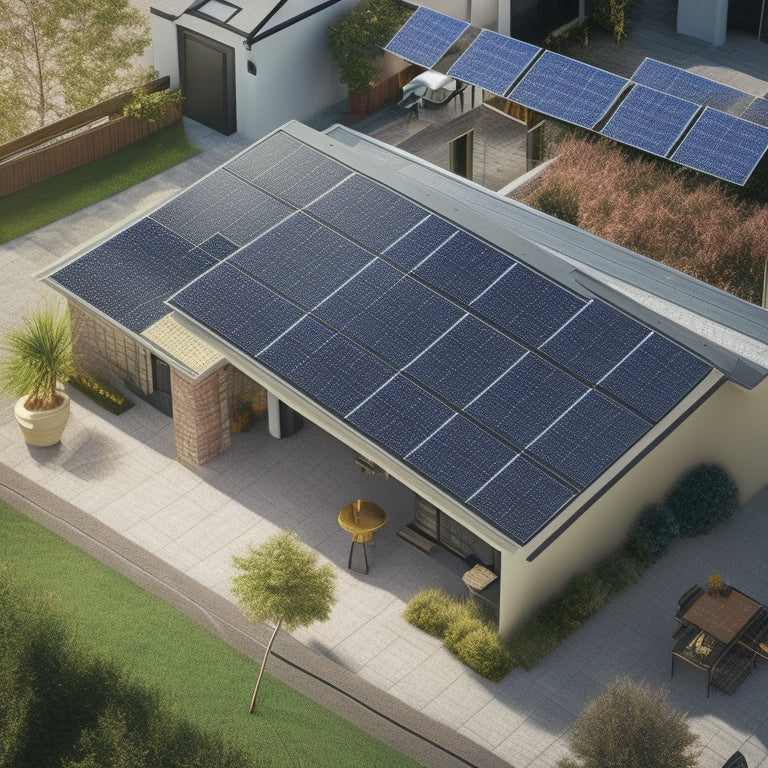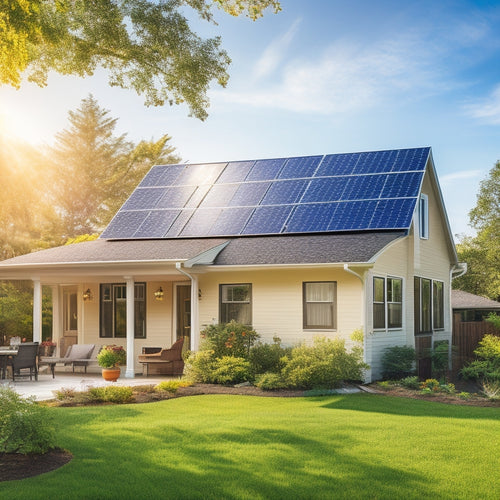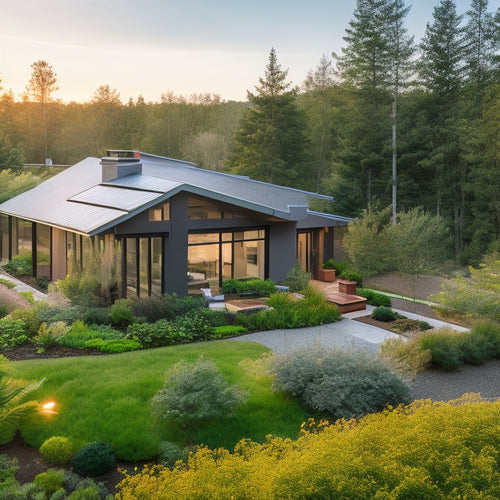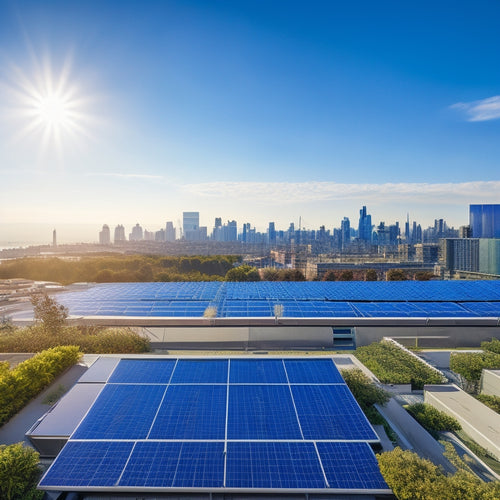
5 Steps to Calculate Solar Panels Required to Power a House
Share
You're looking to calculate the right number of solar panels to power your house. First, determine your energy requirements by calculating your total daily energy consumption and identifying peak hours. Then, assess your roof's solar potential by evaluating its orientation, size, and shading. Next, calculate your solar panel needs based on your energy usage and peak sun hours. After that, consider energy efficiency factors to minimize your overall energy consumption. Finally, size your solar panel system by evaluating your energy needs alongside peak sun hours, and research installation costs to guarantee a cost-effective selection - and that's just the beginning of your expedition to utilizing solar energy.
Key Takeaways
- Calculate total daily energy consumption in kWh to determine the required solar panel output in watts.
- Assess the roof's solar potential by evaluating orientation, size, and shading to identify optimal panel locations.
- Determine peak sun hours based on location and roof conditions to accurately size the solar panel system.
- Consider energy efficiency factors, such as insulation, LED bulbs, and smart home devices, to minimize energy consumption and reduce solar panel requirements.
- Size the solar panel system based on daily energy usage and peak sun hours, considering installation costs and panel type efficiency.
Determine Your Energy Requirements
Calculating your energy requirements is an essential step in determining the number of solar panels your house needs. To do this, you'll need to calculate your total energy consumption in kilowatt-hours (kWh) per day. You can do this by looking at your past electricity bills or using an energy monitoring device.
Identify your peak hours, which are typically between 7 am and 10 am, and 4 pm and 7 pm, when energy usage is highest.
Add up the wattage of all your appliances, lights, and devices to get your total energy load. Consider the efficiency of each device, as well as any energy-intensive habits, such as running multiple computers or power tools.
You should also consider any energy-hungry systems, like your HVAC or water heater. Be sure to account for any energy usage patterns that may vary by season, such as increased heating or cooling needs.
Assess Your Roof's Solar Potential
Get a bird's-eye view of your roof's solar potential by evaluating its orientation, size, and obstructions.
You'll want to determine the roof's orientation, as south-facing roofs receive the most sunlight. East- and west-facing roofs also work well, but north-facing roofs are less ideal. Measure your roof's size to determine how much space is available for solar panels.
Next, conduct a shading analysis to identify any obstructions that could reduce your solar panel system's efficiency. Shading from trees, chimneys, or neighboring buildings can greatly impact your system's performance.
You can use online tools or consult with a solar expert to perform a shading analysis. This will help you ascertain the best location for your solar panels and make sure they're installed at the best angle.
Calculate Your Solar Panel Needs
Determining your solar panel needs requires a thorough understanding of your energy requirements and the amount of sunlight your roof receives.
You'll need to calculate your total daily energy usage in watt-hours (Wh). This can be done by reviewing your past electricity bills or using an energy monitoring device. Be certain to account for any energy-intensive appliances or systems in your home.
Next, you'll need to determine the peak sun hours (PSH) your roof receives per day. This varies depending on your location, roof orientation, and shading. You can use online tools or consult with a solar professional to determine your PSH.
With this information, you can calculate the required solar panel output in watts.
When selecting solar panel types, consider factors such as efficiency, durability, and cost. Higher-efficiency panels may be more expensive, but they can provide more power per unit area.
Installation costs will also vary depending on the complexity of the installation, local labor rates, and permits required.
Consider Energy Efficiency Factors
Optimizing your home's energy efficiency is crucial to maximizing the benefits of your solar panel system. By reducing your energy consumption, you can minimize the number of solar panels required to power your house, which in turn reduces the overall cost of the system.
To achieve this, focus on the following energy efficiency factors:
-
Home insulation: Verify your home is well-insulated to prevent heat from escaping during winter and entering during summer. This reduces the load on your heating and cooling systems.
-
Energy saving appliances: Replace traditional incandescent bulbs with LEDs and use energy-efficient appliances to minimize standby power consumption.
-
Window orientation and shading: Strategically place windows to maximize natural light and reduce the need for artificial lighting. Install shades or blinds to prevent heat gain during summer.
- Smart home devices: Install smart thermostats and sensors to optimize your HVAC system's performance and automate energy-saving tasks.
Size Your Solar Panel System
Now that you've optimized your home's energy efficiency, you're ready to determine the right size for your solar panel system. This involves calculating your total energy needs and choosing the right solar panel types to meet those needs.
To do this, you'll need to evaluate your daily energy usage in watt-hours (Wh), along with the peak sun hours (PSH) in your area. PSH refers to the amount of solar energy available per day.
The following table provides a general guideline for sizing your solar panel system:
| Daily Energy Usage (Wh) | Peak Sun Hours (PSH) | Required Solar Panel Size (W) |
|---|---|---|
| 10,000 - 20,000 | 4 - 5 | 2,000 - 4,000 |
| 20,000 - 30,000 | 5 - 6 | 4,000 - 6,000 |
| 30,000 - 40,000 | 6 - 7 | 6,000 - 8,000 |
| 40,000 - 50,000 | 7 - 8 | 8,000 - 10,000 |
Keep in mind that installation costs vary depending on the size and type of solar panels you choose. Be sure to research and compare prices to find the most cost-effective option for your needs.
Frequently Asked Questions
Can I Install Solar Panels on a Shady or North-Facing Roof?
You can install solar panels on shady or north-facing roofs, but you'll face energy production limitations; consider a larger system or more efficient panels to compensate for reduced energy output.
How Long Does a Typical Solar Panel System Last?
As you envision a sea of solar panels utilizing the sun's energy, you wonder about their durability. Typically, a solar panel system lasts around 25-30 years, with minimal maintenance requirements, ensuring a long-lasting, reliable source of power for your home.
Do Solar Panels Work During Power Outages?
You'll stay powered during outages with solar panels, but only if you've invested in battery storage, achieving grid independence; without it, your system will shut down for safety reasons, leaving you in the dark.
Can I Sell Excess Energy Back to the Grid?
Imagine utilizing the sun's energy and getting paid for it! With net metering benefits, you can sell excess energy back to the grid through energy buyback programs, offsetting your utility bills and turning your home into a mini power plant.
Are There Any Government Incentives for Solar Panel Installation?
You'll be thrilled to know that, yes, government incentives exist for solar panel installation; you're eligible for government rebates and solar tax credits, which can considerably reduce your upfront costs, making your switch to renewable energy more affordable.
Conclusion
You've made it! Now, you're just a few watts away from utilizing the sun's energy to power your home sweet home. By following these 5 steps, you've got a solid plan to calculate the solar panels required to meet your energy needs. With your newfound knowledge, you'll be basking in the glow of renewable energy in no time. So, go ahead, soak up the sun, and let your solar panel system do the rest!
Related Posts
-

How to Finance Home Solar Panels
Financing home solar panels offers several strategies to lighten your initial costs while maximizing long-term benefi...
-

Sustainable Home Design for Reduced Carbon Footprint
Sustainable home design is your pathway to a smaller carbon footprint and a healthier living space. By incorporating ...
-

Business Solar Investments for Cost-Effective Sustainability
Investing in solar energy is a smart move for your business, providing a solid foundation for cost-effective sustaina...


